Excerpts from Jim Conrad's
Naturalist Newsletter
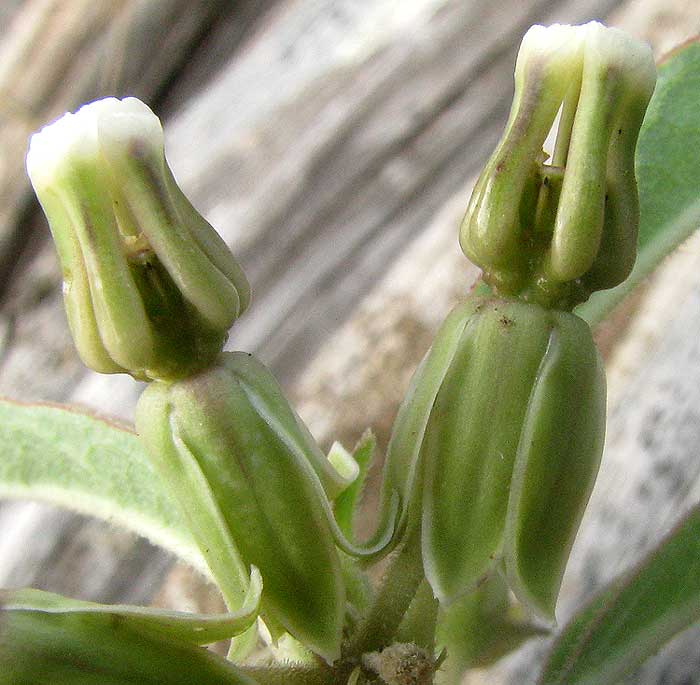
from the July 6, 2014 Newsletter issued from the Frio Canyon Nature Education Center in the valley of the Dry Frio River in northern Uvalde County, southwestern Texas, on the southern border of the Edwards Plateau; elevation ~1750m (~5750 ft); N29.62°, W99.86°; USA
SIDECLUSTER MILKWEED
Beside the little road running up the Dry Frio Valley, growing up through a pile of Ashe Juniper posts eventually to be used for building a fence, an herbaceous plant caught my eye because its leaves were similar to our abundant roadside weed the Silverleaf Nightshade, but its flowers weren't nightshade flowers and, once I looked closer, the leaves were two to a node, or "opposite," instead of the typical one leaf per node, or "alternate," of nightshades. You can see the whole thing below:
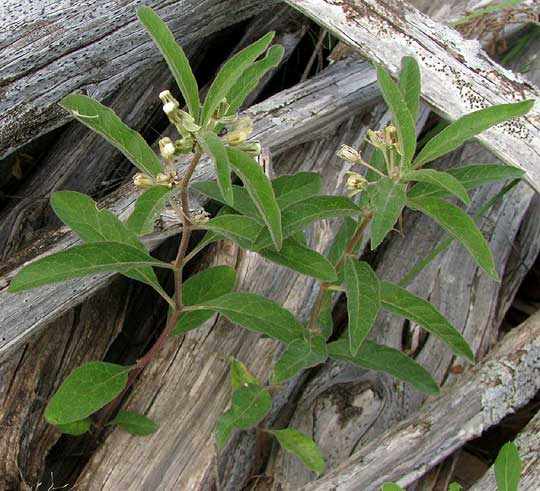
On hands and knees I could see from the flowers' very distinctive form that this was a species of milkweed I'd never seen. A flower close-up appears at the top of this page.
Flowers of most milkweed species are numerous and closely packed in ball-like inflorescences, but here each cluster included only three to seven or so loosely held flowers. Also, many milkweed species hold their inflorescences at the tips of their branches, above their leaves, but on this plant flower clusters arose lower down, from where leaves attached to the stems.
Milkweed flowers are so unusual that to get to know them you must learn special milkweed-flower concepts, such as those of the corona, horn, and gynostegium. We provide a page just on milkweed-flower anatomy at http://www.backyardnature.net/fl_milkw.htm.
If you understand typical milkweed-flower anatomy, then you'll see in our flower picture that this species' corona limbs, or "hoods," are exceptionally slender and rise far above the gynostegium. Also, most milkweed flowers are some other color than green, especially pinkish, red or white.
Our roadside milkweed was such an atypical milkweed that it was pretty easy to figure out. It's variously called the Sidecluster Milkweed, Zizotes Milkweed, Texas Milkweed, Longhorn Milkweed, Primrose Milkweed, Lindheimer's Milkweed, and other names. It's ASCLEPIAS OENOTHEROIDES, a mostly tropical plant distributed from Costa Rica north through Mexico, entering the US in southern Arizona, New Mexico, Texas and Oklahoma.
A 2008 paper by Ana Mercedes Fernández entitled "Usos de las Especies del género Asclepias" reports that in Mexico backcountry folks apply the milky latex produced by Sidecluster Milkweed to painful teeth, and despite the latex containing certain toxic alkaloids, the fruit is reported as edible. I wouldn't try eating them without cooking them and pouring off the juice, though. Elsewhere I read that traditionally Native Americans made a poultice from the plant for skin rashes.
Sidecluster Milkweed is described as growing in sandy, rocky conditions, prairies, ditches and fields, to which we can now add roadsides.
entry dated September 9, 2022, issued from near Tequisquiapan; elevation about 1,900m, (6200 ft), ~N20.57°, ~W99.89°; Querétaro state, MÉXICO
SIDECLUSTER MILKWEED IN MEXICO
At the weedy, grassy edge of a large, overgrazed, abandoned field, a rather scruffy looking weed caught my attention because: 1) Its tough, crinkle-margined leaves were arranged symmetrically giving the plant a slender pagoda-like appearance; 2) It was crawling with orange aphids, and; 3) It bore greenish, star-shaped flowers. Up close, I recognized an old friend from Texas (previous entry):

It was the Sidecluster Milkweed, Asclepias oenotherioides, but this time heavily infested with orange aphids. Earlier, I didn't go into the details of how the milkweed flower's very unusual structure accomplishes pollination. Now, looking closely at the conspicuous white-tipped "nose" on this plant's flower, is a good time to do that.
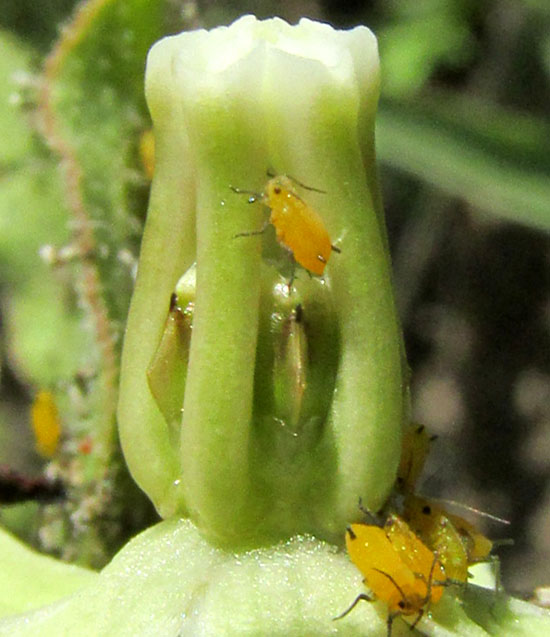
From the side, it's almost as if the five tall, slender hoods form a cage for the thick, flat-topped gynostegium inside it. The gynostegium is the most distinctive feature of all milkweed flowers. In the above picture, you can see a single, grain-like, dark "corpusculum" between each pair of hoods, near the top of the gynostegium. The corpusculum is attached to two "translator arms," which aren't visible in the picture. At the tips of each arm resides a pollinium, which is a waxy package of pollen. The whole upside-down-V-shaped structure formed by the corpusculum at the center and the down-slanting translator arms, is called the "pollinarium." A pollinator's leg slips between any two of the five hoods, snags on a translator arm, and when the insect jerks its leg upward, the whole upside-down-V-shaped polinarium goes with it. At the next flower, the idea is for the pollen-bag pollinia to contact the gynostegium's flat top, the stigmatic disk, at which point pollination is accomplished.
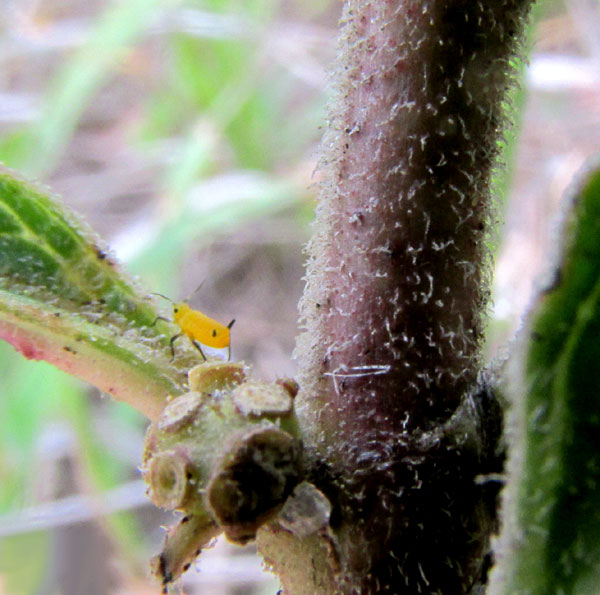
Beyond the exceedingly slender, tall hoods and their splendiferously white tops, Sidecluster Milkweed's stems are unusually dark purplish and rough hairy. As the above picture shows, though the plant is herbaceous, it's clearly a perennial, as indicated by the scarred point of attachment of one of last season's fruits indicates, just below an aphid. In fact, a nearby plant still bore the dried-up, empty husk of one of last season's capsular-type fruits:
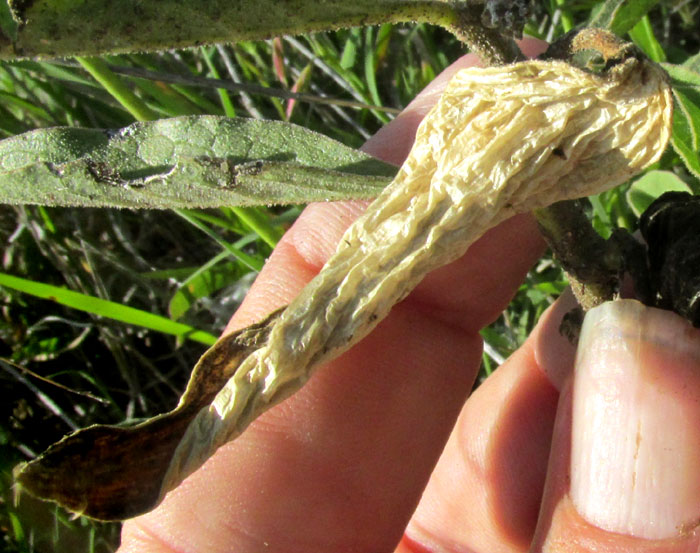
This species is so tough and displays such unusual features with those tall, slender hoods, that I was curious to know whether in recent years advances in evolutionary biology may indicate that Sidecluster Milkweed's curious features are "primitive" -- that the species is ancestral for more "typically looking" species, such as the "Pringle's Milkweed" recently met on a mountain near here.
In 2018, Mark Fishbein and others published "Evolution at the tips: Asclepias phylogenomics and new perspectives on leaf surfaces." Reporting on very comprehensive studies of many milkweed species in many places, that fine study provides several "maximum likelihood phylograms." Phylograms are branching, tree-like diagrams in which primitive species appear on branches near the roots, while most recently arisen species occur higher up, at outer branch tips. Producing such diagrams showing which species begat later species, and how different major branches, or "clades," of the tree incorporate species derived from a common ancestor, is the goal of today's gene sequencers. At this writing in 2022, the above study with its gorgeous phylograms is available for free at the ResearchGate.Net website.
The phylograms, by showing the Sonoran Desert clade immediately branching off the main root, indicate that the milkweed genus Asclepias may have arisen in the Sonoran Desert region. The position of our Asclepias oenotherioides inside the Temperate North America clade, and as one of the most recently branching-off taxa within that clade, suggests that Sidecluster Milkweed is one of the most recently arisen milkweed species. Therefore, our flowers with hoods strangely tall and narrow, and the plant's tough leaves and rough stems, are more likely newly evolved innovations than primitive features.
Once you've seen several milkweed species in various places and have a general idea of what milkweeds are all about, being able to visualize milkweed history as an ever-evolving tree growing up through time and geographic space, with big branches and little ones, some of which wither and maybe die off and others who prosper -- the very things the phylograms seek to portray -- is quite a buzz.
With regard to the aphids, when I checked to see what kind of pictures the Mexican government had of Sidecluster Milkweed -- such as its page on the Malezas de México website, the "Weeds of Mexico," where it's called Zizotes -- some of their pictures also included plenty of orange aphids. Moreover, Wikipedia's page on the aphid Aphis nerii, often called the Milkweed Aphid, Oleander Aphid and several other names, has pictures of Milkweed Aphids on our plant. The Milkweed Aphid is native of the Mediterranean region, but now found throughout the world in tropical and warm countries.